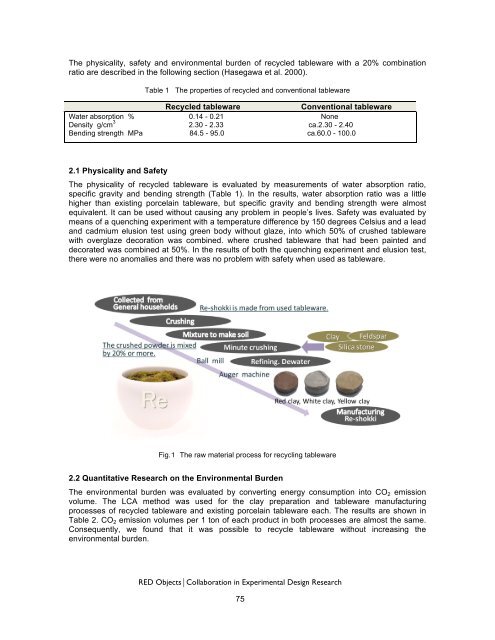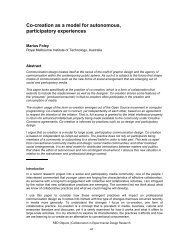Ceramic Tableware Recycling by Green Life 21 Project - Red Objects
Ceramic Tableware Recycling by Green Life 21 Project - Red Objects
Ceramic Tableware Recycling by Green Life 21 Project - Red Objects
You also want an ePaper? Increase the reach of your titles
YUMPU automatically turns print PDFs into web optimized ePapers that Google loves.
The physicality, safety and environmental burden of recycled tableware with a 20% combination<br />
ratio are described in the following section (Hasegawa et al. 2000).<br />
Table 1 The properties of recycled and conventional tableware<br />
Recycled tableware Conventional tableware<br />
Water absorption % 0.14 - 0.<strong>21</strong> None<br />
Density g/cm 3 2.30 - 2.33 ca.2.30 - 2.40<br />
Bending strength MPa 84.5 - 95.0 ca.60.0 - 100.0<br />
2.1 Physicality and Safety<br />
The physicality of recycled tableware is evaluated <strong>by</strong> measurements of water absorption ratio,<br />
specific gravity and bending strength (Table 1). In the results, water absorption ratio was a little<br />
higher than existing porcelain tableware, but specific gravity and bending strength were almost<br />
equivalent. It can be used without causing any problem in people’s lives. Safety was evaluated <strong>by</strong><br />
means of a quenching experiment with a temperature difference <strong>by</strong> 150 degrees Celsius and a lead<br />
and cadmium elusion test using green body without glaze, into which 50% of crushed tableware<br />
with overglaze decoration was combined. where crushed tableware that had been painted and<br />
decorated was combined at 50%. In the results of both the quenching experiment and elusion test,<br />
there were no anomalies and there was no problem with safety when used as tableware.<br />
Fig.1 The raw material process for recycling tableware<br />
2.2 Quantitative Research on the Environmental Burden<br />
The environmental burden was evaluated <strong>by</strong> converting energy consumption into CO2 emission<br />
volume. The LCA method was used for the clay preparation and tableware manufacturing<br />
processes of recycled tableware and existing porcelain tableware each. The results are shown in<br />
Table 2. CO2 emission volumes per 1 ton of each product in both processes are almost the same.<br />
Consequently, we found that it was possible to recycle tableware without increasing the<br />
environmental burden.<br />
RED <strong>Objects</strong>⏐⏐Collaboration in Experimental Design Research<br />
75




